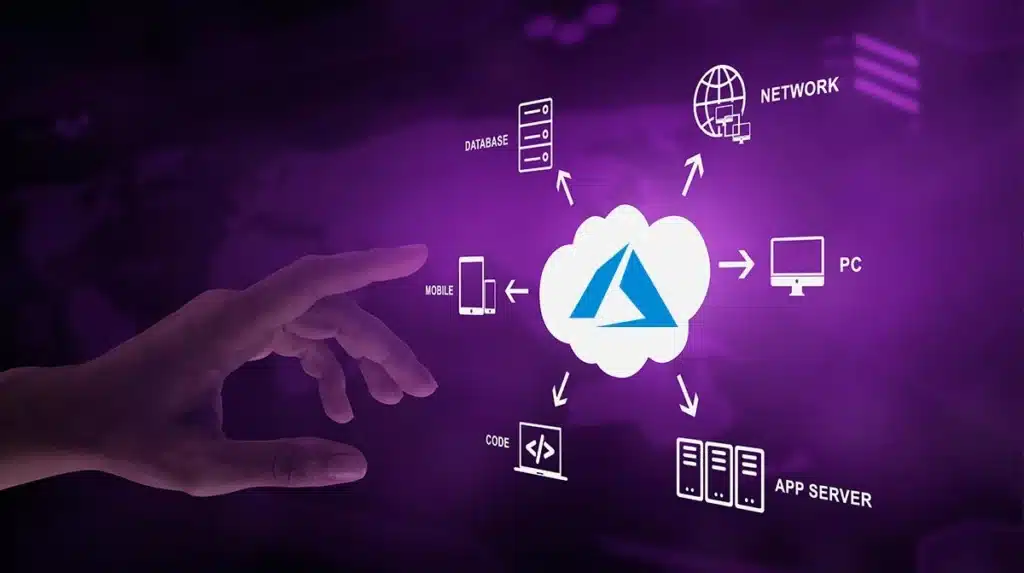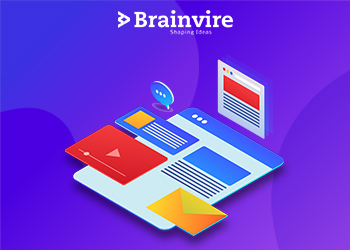If you’re tasked with building a cloud solution that must scale with demand, ensure top-tier security, and optimize costs. Where do you begin? With its extensive cloud services and powerful architecture tools, Microsoft Azure provides the answer.
Whether you’re an experienced cloud architect or just stepping into this role, mastering Azure solutions can set you apart. This blog will guide you through the key aspects of architecting robust, scalable, and secure Azure cloud solutions.
Why Microsoft Azure?
Microsoft Azure is one of the leading cloud service providers, serving over 95% of Fortune 500 companies. With more than 200 products and cloud services, Azure enables businesses to build, manage, and deploy applications across a global network of data centers. According to Gartner, Azure holds a 22% share of the cloud infrastructure services market, second only to AWS. The platform’s extensive toolset, compliance capabilities, and AI integration make it a go-to choice for enterprises worldwide.
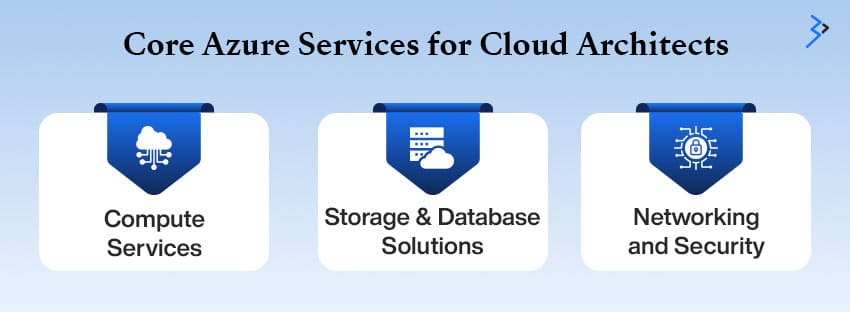
Core Azure Services for Cloud Architects
1. Compute Services
Azure offers multiple computing services to handle workloads efficiently:
- Virtual Machines (VMs): Provides flexible computing capacity, supporting Linux and Windows-based workloads
- Azure App Services: A fully managed platform for building, deploying, and scaling web apps
- Azure Kubernetes Service (AKS): Simplifies container orchestration and microservices deployment
- Azure Functions: Enables serverless computing, allowing you to execute code on demand without infrastructure management
2. Storage and Database Solutions
- Azure Blob Storage: Scalable object storage for unstructured data
- Azure SQL Database: Managed relational database service with AI-powered performance tuning
- Cosmos DB: A globally distributed, multi-model database ensuring millisecond response times
[ Read more: Mastering Data Visualization with Power BI ]
3. Networking and Security
- Azure Virtual Network: Establishes secure connections between resources
- Azure Front Door: Enhances application security and performance with global load balancing
- Azure Firewall & Security Center: Implements threat protection and compliance monitoring
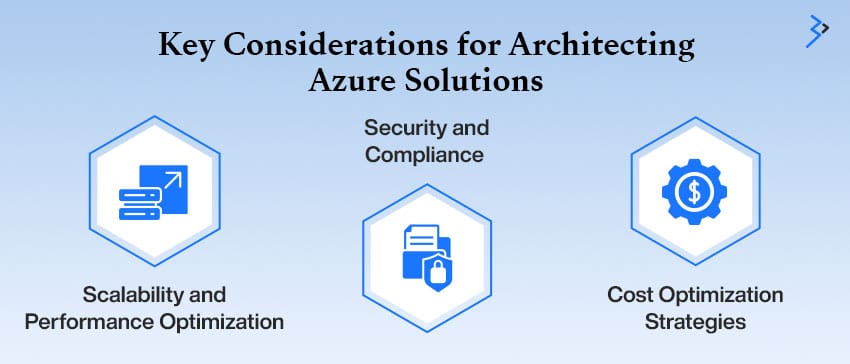
Key Considerations for Architecting Azure Solutions
1. Scalability and Performance Optimization
Cloud solutions must scale efficiently to meet fluctuating demand. Azure supports both vertical and horizontal scaling:
- Vertical Scaling: Increases VM resources like CPU and memory
- Horizontal Scaling: Adds more instances of a resource to distribute traffic
- Auto-scaling: Dynamically adjusts resources based on workload patterns
- Azure Load Balancer: Distributes network traffic across multiple servers for optimal performance
2. Security and Compliance
Data breaches can cost enterprises an average of $4.35 million per incident (IBM Cost of a Data Breach Report, 2022). Azure addresses security challenges by:
- Implementing multi-factor authentication (MFA)
- Encrypting data with Azure Key Vault
- Conducting regular security audits using Azure Security Center
- Meeting compliance standards such as GDPR, HIPAA, and ISO 27001
[ Read more: Adobe Commerce Security Best Practices ]
3. Cost Optimization Strategies
According to Flexera’s 2023 State of the Cloud Report, 82% of organizations cite managing cloud costs as a significant challenge. Azure provides tools like:
- Azure Cost Management + Billing: Tracks and optimizes cloud expenditures
- Reserved Instances (RIs): Saves up to 72% on long-term VM commitments
- Azure Hybrid Benefit: Reduces licensing costs for Windows and SQL Server workloads

The Role of DevOps in Azure Architecture
Azure architects must integrate DevOps practices to streamline development and operations. Key DevOps strategies include:
- Infrastructure as Code (IaC): This approach automates deployments using tools like Terraform and Azure Resource Manager (ARM) templates
- CI/CD Pipelines: Azure DevOps and GitHub Actions automate build and release processes
- Monitoring and Logging: Azure Monitor and Application Insights provide real-time analytics for performance tracking
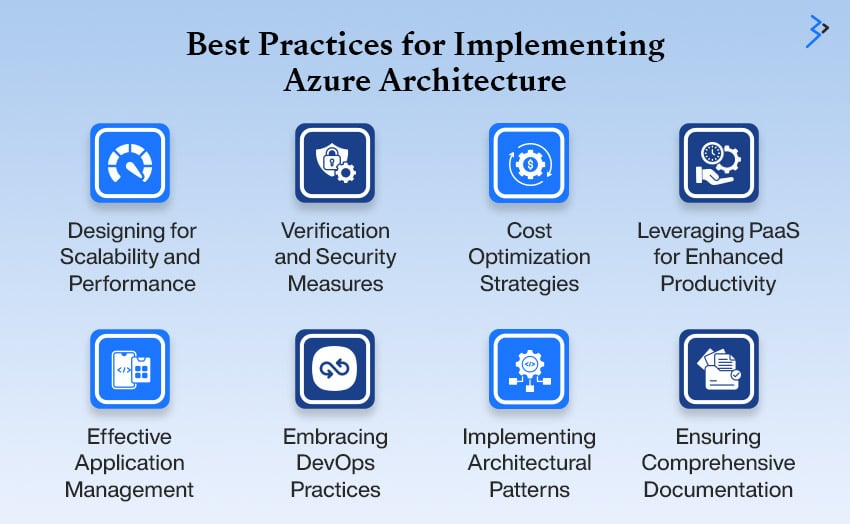
Best Practices for Implementing Azure Architecture
- Designing for Scalability and Performance
Leveraging Azure’s built-in tools is essential to ensuring optimal performance and scalability. Brainvire employs Azure autoscaling to dynamically adjust resources based on real-time demand. Load balancers distribute incoming traffic efficiently across multiple servers, preventing bottlenecks. Additionally, Azure Cache for Redis helps cache frequently accessed data, reducing database load and enhancing response times.
- Verification and Security Measures
Security and compliance are at the core of Azure architecture. Brainvire integrates Azure Active Directory (AAD) for identity and access management, ensuring secure authentication. Network Security Groups (NSGs) and Azure Firewalls help regulate inbound and outbound traffic, while Azure Encryption Services safeguard data in transit and at rest.
- Cost Optimization Strategies
Brainvire utilizes Azure Reserved Instances to optimize costs for predictable workloads, significantly reducing expenses. Azure Cost Management and Billing tools help monitor and refine cloud expenditures, ensuring financial efficiency while maintaining operational effectiveness.
[ Read more: Dynamics 365 Development for ERP and CRM ]
- Leveraging PaaS for Enhanced Productivity
Azure’s Platform as a Service (PaaS) offerings, such as Azure App Services and Azure Functions, streamline application deployment and management. These services enable seamless scaling and reduce maintenance efforts, allowing businesses to focus on innovation rather than infrastructure management.
- Effective Application Management
Brainvire ensures robust application monitoring using Azure Application Insights, providing real-time performance analytics. Azure Monitor tracks logs and system metrics, while automated alerts enable proactive issue resolution before they impact end users.
- Embracing DevOps Practices
Azure DevOps and GitHub Actions facilitate seamless continuous integration and continuous deployment (CI/CD). Infrastructure as Code (IaC) tools like Azure Resource Manager (ARM) templates, Terraform, and Bicep enable automated and consistent infrastructure provisioning.
- Implementing Architectural Patterns
Modern applications require flexible architectures. Brainvire adopts a microservices architecture,
leveraging Azure Event Grid and Azure Service Bus for event-driven communication. These patterns enhance scalability, maintainability, and fault tolerance.
- Ensuring Comprehensive Documentation
Proper documentation is key to maintaining architectural consistency. Brainvire ensures thorough documentation of all Azure deployments, sharing knowledge across teams to streamline operations and improve understanding.
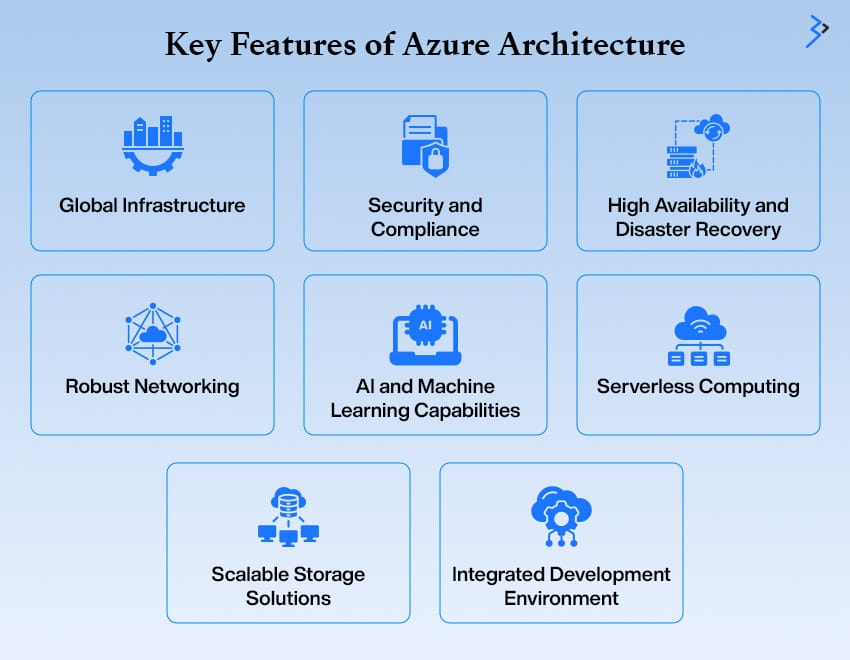
Key Features of Azure Architecture
1. Global Infrastructure
Azure operates across multiple geographical regions, ensuring seamless service delivery and minimal latency. Its globally distributed data centers provide independent power, cooling, and networking infrastructure, enhancing resilience and minimizing downtime. With region-based availability zones, businesses can deploy applications closer to their end users, improving performance and accessibility.
2. Security and Compliance
Azure prioritizes enterprise-grade security with Azure Security Center and Azure Active Directory (AAD) to protect sensitive data and ensure regulatory compliance. Organizations benefit from role-based access control (RBAC), multi-factor authentication (MFA), and end-to-end encryption, safeguarding applications against unauthorized access and cyber threats. Compliance certifications such as ISO, GDPR, HIPAA, and FedRAMP make Azure a trusted platform for industries with stringent security requirements.
3. High Availability and Disaster Recovery
Azure ensures business continuity through robust high availability (HA) and disaster recovery (DR) solutions. With Azure Backup, businesses can securely back up critical data, while Azure Site Recovery enables seamless failover and minimal disruption in case of system failures. The geo-redundant storage (GRS) feature further enhances resilience by replicating data across multiple locations.
4. Robust Networking
Azure offers a highly reliable and secure networking infrastructure with private virtual networks (VNETs), ExpressRoute, and VPN gateways. These features enable businesses to connect securely between on-premises data centers and Azure environments. Azure Load Balancer and Azure Traffic Manager also help distribute workloads efficiently, optimizing network performance and availability.
5. AI and Machine Learning Capabilities
Azure provides an integrated AI and machine learning ecosystem with tools like Azure Machine Learning, Cognitive Services, and AI-powered analytics. Businesses can build, train, and deploy intelligent models using pre-built APIs for speech recognition, image processing, and natural language understanding, accelerating innovation without complex infrastructure management.
6. Serverless Computing
With Azure Functions and Logic Apps, businesses can run event-driven applications without managing servers. Serverless computing enables automatic scaling, cost efficiency, and simplified execution of background tasks, real-time data processing, and microservices-based applications.
7. Scalable Storage Solutions
Azure provides a range of cloud-based storage options, including Blob Storage, Azure Files, Table Storage, and Managed Disks. Businesses can efficiently store and retrieve structured and unstructured data while ensuring high durability and security. Features like auto-scaling, data replication, and encryption at rest make Azure an optimal solution for data-intensive applications.
8. Integrated Development Environment
Azure seamlessly integrates with Azure DevOps, Visual Studio, and GitHub to streamline development, testing, and deployment. Developers can leverage CI/CD pipelines, infrastructure as code (IaC) with Terraform, and automated monitoring tools to enhance productivity and accelerate software delivery. The built-in Azure Monitor and Application Insights provide real-time insights into application performance, enabling proactive issue resolution.
Benefits of Azure Architecture
- Scalability: Azure dynamically allocates resources based on demand, ensuring optimal application performance
- Cost Optimization: Pay-as-you-go pricing and cost management tools help organizations reduce expenses without sacrificing efficiency
- High Availability and Reliability: Redundancy mechanisms ensure minimal downtime and consistent performance
- Enhanced Security: Azure Security Center, encryption, and threat detection provide comprehensive protection against cyber threats
- Hybrid Capabilities: Azure supports seamless hybrid cloud integration with Azure Arc and Azure Stack, offering flexibility for enterprises
- Optimized Performance: Low-latency connections and global distribution ensure high-speed networking and application responsiveness
- Disaster Recovery and Backup: Robust backup and recovery solutions protect business-critical data from disruptions
- Environmental Sustainability: Microsoft’s commitment to renewable energy and sustainability ensures Azure’s operations remain eco-friendly
By implementing Azure’s best practices, Brainvire helps businesses achieve scalability, security, and cost efficiency, transforming their digital infrastructure for future-ready growth.
Azure Certifications for Solutions Architects
Azure certifications validate expertise and help professionals advance in their careers. Consider these key certifications:
- Microsoft Certified: Azure Fundamentals (AZ-900): Ideal for beginners to understand core cloud concepts
- Microsoft Certified: Azure Solutions Architect Expert (AZ-305): Advanced certification focusing on designing secure, scalable, and resilient solutions
Hands-on Learning and Community Engagement
1. Experiment with Azure’s Free Tier
Azure offers a free account with $200 in credits for 30 days, plus always-free services like Virtual Machines, Storage, and AI models.
2. Participate in Open-Source Projects
Contributing to Azure-based open-source projects on GitHub enhances practical skills and builds industry connections.
3. Join Azure User Groups and Forums
Networking with Azure professionals through Microsoft Tech Community, Azure Meetup Groups, and LinkedIn Communities keeps you updated with industry trends.

Future Trends in Azure Cloud Architecture
- AI and Machine Learning Integration: Azure AI and Azure Machine Learning empower businesses with predictive analytics
- Quantum Computing: Azure Quantum provides cloud-based quantum computing capabilities
- Serverless and Edge Computing: The rise of Azure IoT Edge and Azure Functions ensures efficient, real-time data processing
Final Thoughts
Architecting cloud solutions with Microsoft Azure involves more than deploying virtual machines and databases—it’s about designing scalable, secure, and cost-efficient architectures. By mastering Azure services, adopting DevOps practices, and continuously upskilling, you can build resilient cloud-native applications that drive business success.
So, where will you start your Azure journey today?
Related Articles
-
Will Microsoft Teams Replace SharePoint Intranets?
During the initial phase of the COVID-19 pandemic, when businesses suddenly needed digital workspaces to support a remote workforce, the company’s intranet became an inseparable tool for communicating the latest
-
Reasons Why SharePoint Enterprise Content Management System is Optimal for Your Business
Enterprises process a pool of diverse content regularly. This comprises videos, images, emails, documents, and web content. It’s quite a tedious task to manage the content that is to be
-
Benefits of SharePoint Intranet for Financial Institutions
SharePoint is a system that may help companies of any size deal with a wide range of operational difficulties. Document management is the first thing that comes to mind when

